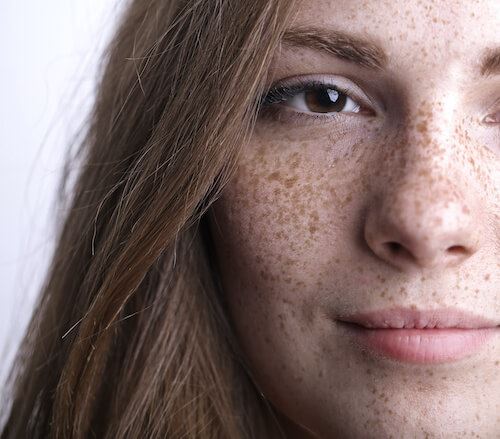
How to Treat the Different Types of Pigmented Skin Lesions
The appearance of anyone’s skin is based largely on factors like:
- Genetics
- Sun exposure
- Past injuries
- How well the skin is cared for
- And more
What Is a Pigmented Skin Lesion?
A pigmented lesion is a spot on the skin, usually brown or a similar dark color, created by having too much melanin in the skin. According to the Australian Journal of General Practice, pigmented skin lesions are commonly benign and are seen on people every day.
While pigmented skin lesions are generally harmless, it’s important to monitor any you have and see a medical professional if they change:
- Shape
- Color
- Or size
Some types may be more at risk of becoming malignant than others, but only a medical professional can determine that. We’ve discussed some of the most common types of pigmented lesions and what pigmented lesion treatment is available to remove them for cosmetic purposes.
Freckles
Freckles are some of the most common types of pigmented lesions, and they appear primarily in fair-skinned people. These are seen as small brown marks flat on the surface of the skin. They can be present anywhere on the body but are most prominent in areas exposed to the sun, like the face and arms.
The vast majority of freckles are harmless and can sometimes be reduced by limiting direct sun exposure. Laser therapy is available to help reduce the appearance of freckles if they are in visible places like the facial area.
Age Spots Or Sunspots
Age spots and sunspots are often called the same thing and generally occur on a person’s skin as they get older. While these spots are generally benign as well, since they are a direct result of excessive sun exposure, they may need a little more attention and monitoring to ensure they don’t turn into anything more.
Protecting age spots and sunspots is important since additional sun exposure can be harmful to them. These types of skin spots can be of various shapes and sizes and may be reduced with laser therapy depending on the size and location.
Moles and Birthmarks
Moles and birthmarks can be present on a person’s skin immediately when they are born.
Moles develop as a result of a collection of melanocytes in the skin and can be:
- Small
- Large
- Flat
- Round
- Dark
- Light
- Or have other characteristics
The smaller the mole is, the better the chances are of it being a candidate for a pigmented lesion laser treatment. Otherwise, it may have to get cut out if it’s too large. Birthmarks occur when the body has an overgrowth of cells and leads to the pigment in the skin. These can be found anywhere on the body and are virtually harmless.
Some birthmarks will slowly fade away with age, but others could stay for many years. A laser therapy treatment could reduce the appearance of a visible birthmark significantly.
What Is the Best Treatment Option for Pigmented Skin Lesion Removal?
Many people can successfully reduce the appearance of their pigmented lesions by avoiding sun exposure. Some people even use whitening creams to reduce their appearance of them temporarily. However, one of the most effective and long-lasting treatment options is a pigmented lesion laser treatment.
How Does Pigmented Lesion Laser Treatment Work?
It works by sending a laser beam through the skin’s layers to create tiny spaced columns. The body naturally goes to work repairing those columns and pushes out the old skin while replacing it with new skin. Since the laser is targeted and extremely precise, only the affected areas are treated, and the rest of the skin is left untouched, which helps the recovery process significantly.
Types of Lesions a Pigmented Lesion Laser Treatment Can Improve
Freckles, sunspots, birthmarks, and some types of moles can have their appearances reduced with a pigmented lesion treatment. With laser therapy, the entire face can be treated in about 30 minutes, and most people report minimal discomfort throughout the process.
How Many Treatments Do You Need to See Results?
A single treatment can provide significant visible results and will often remove the pigmented lesion completely on the first treatment. However, people with severe discoloration may need multiple treatments to remove it completely.
Following the pigmented lesion laser treatment, the lesion should not return, but new ones can develop due to:
- Sun exposure
- Aging
- And other factors
Consult A Medical Professional About Concerning Pigmented Skin Lesions
Working with a reputable medical professional who is highly trained and experienced working with lasers can make for a great experience. According to DermNet NZ, pigmented lesions are mostly melanocytic but can also be non-melanocytic. Anyone with pigmented lesions should have them checked by a medical professional regularly to determine the type and to ensure they do not turn malignant.
It’s also important to monitor them closely and identify any changes in the spots so you can bring the changes to your medical professional’s attention. And if all of your lesions are benign, then you can pursue a pigmented lesion treatment with a qualified medical professional and have them removed if you are a great candidate.
Skin Deep Laser Services wants everyone to feel comfortable in their skin. Pigmented lesions are mostly harmless, but can leave you with unsightly marks on your skin. When these marks are in visible areas like your face, you may consider laser therapy to have them quickly and safely removed.
Our experts use the highest quality lasers and are well-qualified to perform your treatment. If you are interested in pursuing a pigmented lesion laser treatment, contact us today to schedule a free consultation and learn more about the process.


